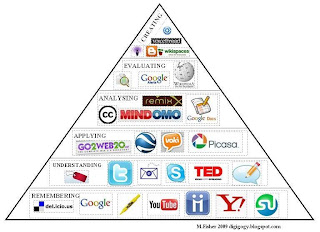 How do teachers promote higher order thinking skills (HOTS)? The conversation may begin with teacher questioning, or with an examination of where current practices fit within Bloom's taxonomy. While Bloom's taxonomy has been part of the educational lexicon since 1956, web technologies of today can be employed to help teachers and students achieve in ways that simply were not possible before.
How do teachers promote higher order thinking skills (HOTS)? The conversation may begin with teacher questioning, or with an examination of where current practices fit within Bloom's taxonomy. While Bloom's taxonomy has been part of the educational lexicon since 1956, web technologies of today can be employed to help teachers and students achieve in ways that simply were not possible before.Within the updated taxonomy, the highest order of thinking is Creating. Below the level of creation is the level of Evaluating. In the past, these were reversed: creating (then called synthesis) was below evaluating (then called evaluation). The reversal reflects the change in what has become important not only within the world of academia, but within the world of work as well. The careers of the new century, we are reminded, will be about creating something new, not simply working with what is already present at hand.
The language of the revised taxonomy matters here. What was called Knowledge is now Remembering. What was Comprehension is now Understanding. Application has become Applying. The shift from noun to verb signals a shift in the focus of education from a goal to be achieved to a period of through through which learners are constantly evolving.
So how can we apply web technologies to meet the new concepts of the taxonomy? First, we can understand how the tools we use in the classroom fall within the taxonomy. Certain web technologies are about retrieving information, such as online flashcards, glossary information posted on Moodle or another CMS, online study guides, etc.
Web 2.0 technologies, however, by their very nature, tend to promote higher order thinking skills.
- Creating a blog, such as this one, requires the author to bring together information from various sources, sort through the information to deliver a cohesive message, and speak from a position of expertise.
- Creating a photostory incorporates more levels of creating, as students select representative images, and in some cases, create their own images to associate with the information they present.
- Students who create, administer, and evaluate the results from questionnaires and polls, such as those that can be made in GoogleDocs are engaged in HOTS of many types.
- It may be old-school with a new technology, but using GoogleDocs to comment on another's writing engages the student in evaluation. The difference, of course, is that the document gains a sense of authenticity once made available through the web.
Using computers in the classroom does not promote higher order thinking skills. Asking students to answer "comprehension questions" online is no more thought-provoking than when you hand them a photocopied page of questions. But web 2.0 technologies can be employed to promote HOTS, if done consistently and with the understanding of Bloom's updated taxonomy.
Hello David,
ReplyDeleteI enjoyed the post on how emerging technologies can super-charge the teaching of higher-order thinking skills. Web 2.0 certainly offers students many more opportunities for creating new work, evaluating reams of data, etc.
My concern is that we're putting Web 2.0 (a Ferrari V12 engine) into a chasis of Bloom's Taxonomy (a Model-T Ford). It's more than 50 years old. And while the revisions are a slight improvement (your notes about verbs vs. nouns and the swap of evaluation and creativity are spot-on), there have been other researchers and educational theories that blow Bloom & Company out of the water. In particular, Dr. Derek Cabrera has spent the past 20 years researching thinking skills and cognition. The resulting theory, the DSRP Method, is at the cutting-edge of this important area of research. I recently wrote a short article for ASCD about the need to 'upgrade' from Bloom's and why DSRP offers a fresh and practical approach to teaching thinking skills:
http://www.ascd.org/ascd-express/vol5/523-wheeler.aspx
Again, many thanks for relating two different areas of research (thinking skills and emerging technologies) and seeing what they have to say to one another. That's something we educators don't do often enough, and it leads to the "one more thing" phenomenon that overwhelms and demotivates so many of us. Keep up the great work!
Thank you so much for your comment. I will pass your suggestion on to our instructional leaders, who presented the staff with Bloom's as a tool to reflect on instruction. I agree with you about DSRP. Perhaps a future post might deal specifically with the synthesis of DSRP and Web 2.0
ReplyDelete